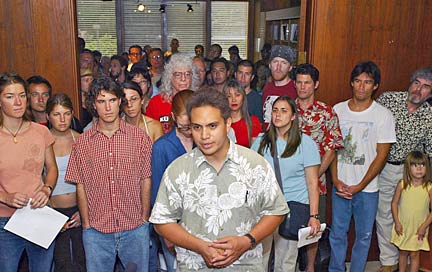
|
UH protesters
declare victory
as sit-in ends
Protesters packed their sleeping bags and tents and ended a seven-day occupation of the University of Hawaii president's office yesterday after accepting a commitment that regents would hold an open discussion on a proposed Navy research center.
"Militarism is not the answer for our university nor for our environment, community or keiki," said protester Christine Noyes, who read a statement for reporters in the foyer of the president's office. "The ethics of the military-industrial complex are not the same as the ethics of a university; the convergence creates a mutation, a perversion we will not accept."
About 100 students, faculty and supporters left Bachman Hall chanting, clapping and cheering after declaring victory but promising they would be back if the proposed University Affiliated Research Center is approved by the president and the Board of Regents.
On Tuesday, UH Interim President David McClain agreed to all but one of the revised demands of the protesters.
McClain said he could not rescind the regents' action to grant provisional approval of the UARC at a meeting in November. But he said a final decision on the center will not be made until October, after full consultation on the issue.
He issued a written statement yesterday, saying he was looking forward "to working with both proponents and opponents of the UARC to frame a full and fair discussion of this issue."
University spokeswoman Carolyn Tanaka said it cost about $5,000 in overtime for campus security during the week-long protest.
The protesters were careful not to damage anything during their occupation, removing their shoes before entering the carpeted office area.
Before leaving Bachman Hall, they cleaned up the outside courtyard and watered the plants.
Navy and UH-Manoa administrators are proposing to establish the research center at Manoa, which would bring up to $10 million a year in Navy-sponsored research to the university during the next five years.
Defense Department spending accounted for about $54 million of the $330 million in outside research and training grants at UH-Manoa, according to the university. Some of the current research also involves classified information.
"This is really business as usual. This is not significantly different than what the university has been doing for decades," said Gary Ostrander, UH vice chancellor for research and graduate education.
Ostrander said much of what the military funds is basic research, such as weather studies, ocean currents, diabetes care and treatment, and the effect of sonar on marine mammals.
"At the end of the day, this is just a different contract vehicle for bringing money from the Navy," he said.
But opponents of the UARC say a key difference is that the Navy would propose research projects that it would fund, rather than researchers coming up with their own projects. Opponents also object to classified research, which they say is not subject to review by peers and would not be accountable to the public.
Opponents also say the UARC will further militarize Hawaii, which already has too many military bases and projects and conflicts with native Hawaiian concerns.
Ikaika Hussey, a protest organizer, said the military has desecrated Mauna Kea, Haleakala and other sites on the islands.
Klaus Keil, interim director of the School of Ocean and Earth Sciences and Technology and a UARC supporter, said researchers will still have a choice of whether to accept a Navy project.
Ostrander said it is a misconception that the university will perform secret weapons research. He said the research, even classified research, will be subject to the same safety rules as all projects at the university.
"We're not going to build atomic bombs here," Keil said.
The research at the UARC will be in "core competencies" in which the university excels, such as ocean sciences and technology, astronomy, optics, and communication and information technology, he said.
If the university does not establish a UARC, Ostrander said it will be a "lost opportunity in a climate where it's getting more and more difficult to fund research."
Karl Kim, a professor in Urban and Regional Planning, said the university should focus on core values in its strategic plan like sustainable development and building on its strengths as a place of Asian and Pacific scholarship, rather than go after defense dollars.
"We should stick with what we set out to do rather than sort of lurching at this opportunity because of the funds," he said.
Kyle Kajioka, one of the protest organizers, said the sit-in was a success because it brought attention to the UARC issue. Awareness of the issue was close to zero before the protest, he said, but 1,000 signatures were collected on a petition against the center in the last three days, he said.
Kajioka said once there is a full airing of the facts about the UARC, McClain will not be able to recommend the project move forward.
"I don't think he could arrive at that conclusion (to recommend the center) if he was seriously listening to and weighing the concerns that we are bringing forward," Kajioka said.
Ostrander said the Manoa administration will continue to meet with university community members in small groups.
He said there are core groups of people on both sides who support and oppose the UARC and that there are a number of people in the middle.
"There is a certain amount of apathy on the issue," Ostrander said. "A lot of folks feel this just doesn't apply to them in any way."
[News] [Business] [Features] [Sports] [Editorial] [Do It Electric!]
[Classified Ads] [Search] [Subscribe] [Info] [Letter to Editor]
[Feedback]
